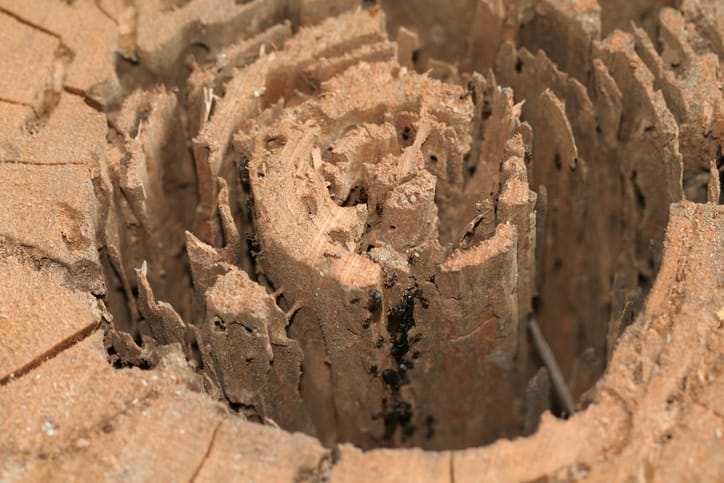Carpenter ants are a common species of ant throughout areas of Canada. They are also a very destructive species of ant. Carpenter ants do not eat wood, but they will destroy it so they can build their nests. They can damage floors, wooden support beams, wood siding, and anything else they come across that is made of wood.
Preventing carpenter ants from entering your home and understanding how to control carpenter ant population from spreading can help you protect your home. If left unchecked, an invasion of carpenter ants can eventually lead to costly repairs. Even without the repairs, their presence is a nuisance that you will want to handle relatively quickly.
Prevention and Control Tips
First, you need to start by controlling the carpenter ant population. A population of carpenter ants can quickly get out-of-control. The best way to control their population is to track down their primary nest. Keep in mind that carpenter ants will often build nests within your walls or under your floors, but they are likely satellite nests.
The primary, or parent nest, is likely located outside your home. Even if you happen to destroy the smaller, secondary nests, it will not stop the spread and invasion of carpenter ants. The primary nest is where the queen resides. She is the one that pumps out offspring, thus increasing the colony’s population.
If you do not destroy the queen and her primary nest, the ants will continue to invade your home and possibly build more secondary nests. There are ways you can destroy the nest using liquid or other chemical insecticides. Of course, the best way to deal with a primary nest is to contact a pest control professional for assistance.
If you do not know the location of the primary nest, you will have to work to find it so you can tackle the problem. Locating the nest may seem difficult especially if the ants have several secondary nests, but it is possible to track it down.
Tracking Down the Nest
Keep in mind that ants are nocturnal creatures, so it is better to search for their primary nest after dark. Grab a flashlight and look for a trail of ants. A trail of ants will likely carry food back to the primary nest to ensure the colony and queen have enough to eat. Keep in mind that you can tempt ants by using sweet baits like honey.
Using the bait, to attract the ants, you will then follow them back to the primary nest. Keep in mind that carpenter ants will search for food as much as one hundred yards from the primary nest. Therefore, if it seems you are walking for too great a distance, chances are, you are not. Keep following the trail of ants until you locate the correct nest.
Once you find the nest, destroy it to ensure that the spread of the colony’s population comes to an end. For assistance, contact a professional. An expert can come out, inspect your home and the surrounding area, and come up with solutions best used to destroy a carpenter ant nest.
Exclusion
Now that you destroyed the nest and your home is ant-free, you will need to keep it that way. Exclusion is the best way to keep carpenter ants out of your home. There are a few ways you can practice methods of exclusion. For starters, make sure you seal up any entrances ants may use to enter your home.
Remember, they are tiny creatures that can fit through the tiniest possible spaces. Make sure you seal cracks that you find in your foundation. You should also seal areas around your windows and doorframe. If you keep wood piles up by your home for firewood, move them to a different location since carpenter ants find wood piles attractive.
Exclusion also involves proper methods of sanitation. Make sure you keep the inside and outside of your home squeaky clean. Clean up food messes immediately and make sure you place food waste in sealed bags. The place opened food in sealed plastic containers so ants cannot get into them.
Ants constantly look for an easy meal, so it is best to prevent them from finding that easy meal in your home. Remove bags of trash from your home and place them in a bin outdoors. Make sure you keep the bin away from your home. Finally, contact a pest control professional to assist you with a carpenter ant infestation.
